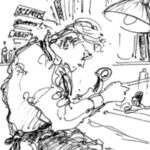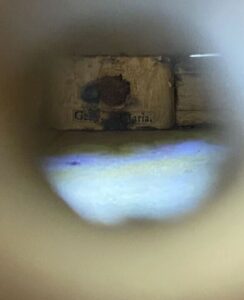Through the eyes of an expert

Expertise is a funny thing. It grows from familiarity, like the proverbial shepherd with his sheep.
If you are surrounded by violins, violas and cellos for long enough, something sinks in- a recognition of a certain way of shaping and finishing, a certain character of design, and even a certain level of craftsmanship. But all this is nothing without memory. A visual ‘photographic’ memory is a necessary thing. Michelangelo, it is said, had a vivid and instantaneous ability to recreate images he had fleetingly seen in the past; like Mozart’s ability to recall precisely a piece of overheard music and transcribe it effortlessly, but for things seen rather than heard.
The ability of a really great expert to recall the face of a violin glimpsed long ago is absolutely a visual one, but it is also necessary to recall the name it went by. One is nothing without the other.
Today we are almost deluged with high quality photographs of instruments. Every detail of every instrument, from the most modest Saxon to the finest Cremonese is, or will shortly be, available with the least effort to the researcher. They can be compared, examined, and recognised with an experienced eye. Modern photography has had huge impact on connoisseurship and understanding.
In the past, it was only the human lens, not the camera and the film, that was capable of gathering all this information. The question is how the experts of earlier times managed to gather and retain their knowledge, and pass it on through their families and apprentices. To people like Luigi Tarisio, Count Cozio di Salabue, John Betts or François Lupot, a perfect frozen image of a violin would have been unimaginable. Yet there are photographs of J.B.Vuillaume and some of his most celebrated instruments taken in the mid nineteenth century. The development of photography in this period had an immediate impact and was taken up very rapidly by publishers and the general public, but a truly decipherable image of a violin took some time to achieve. Certainly by the 1890s, photographs of instruments were being shared and examined by dealers and traders, but it was a brave head that made a firm decision on the evidence of a shadowy monochrome. It made it all too easy for unscrupulous makers to sell crude copies to a poorly-informed public.
The company of W.E.Hill & Sons was founded in this period of rapid change. Yet in their first publication in 1891, ‘The Salabue Stradivari’ (the name they gave the violin now known as ‘The Messie’) was illustrated with watercolour paintings of the violin, which the Hills themselves considered the first accurate reproductions of Stradivari instruments to be published. The artist was Shirley Slocombe, a professional painter who was born in 1872 in Islington, London, and died in Kensington in 1935. For artists like himself, photography was to become a threat.
It is striking that the Hill’s great and definitive ‘Life of Stradivari’ published in 1902 still contains relatively few photographs. It is however full of beautiful drawings, commissioned from Slocombe, which bring details of the great instruments to life.
The Hill’s became acquainted with the Slocombe family probably through Shirley’s brother, Alfred John, who was a violinist and client of the firm. Both Shirley and his father, also Alfred, were professional painters, and collaborated on the initial drawings of the ‘Messie’. Alfred provided the paintings for the volume on Maggini published in 1892. The Hills were hugely impressed with their work, and more commissions to Shirley followed; for the 1690 ‘Tuscan’, the 1704 ‘Betts’ and ‘Glennie’ of the same year, and the 1711 ‘Duport’ cello, all masterpieces of Stradivari. In 1897 Baron Knoop invited him to draw twenty-four instruments from his incomparable collection, which were completed over a period of three years.
This commercial activity continued with his work on the four volume ‘History of English Furniture’ by Percy MacQuoid, published in 1908, which became a classic reference, illustrated throughout by Slocombe. However, he aspired to be a society portraitist, somewhat in the style of his contemporary John Singer Sargent, and in this too, the Hills assisted him with introductions to their own aristocratic connections. In 1894 he made an oil portrait of William Ebsworth Hill which was exhibited at the Royal Academy of Art in the same year. Then in 1899 he painted W.E.Hill’s son Walter, the brother of Alfred and Arthur. Walter and Slocombe were particularly close friends, and Slocombe kept the painting to himself after Walter’s early death in 1905, finally relinquishing it to Arthur in 1918.
This seems to have marked a decline in Slocombe’s life and career, when the Hills also fell out with his violinist brother Alfred, who had been making deals behind their backs of which they disapproved. The years of the First World War, from 1914 to 1918, were in fact a boom time for portraitists, called upon to depict the sons of nobility before their departure for the battlefields.
There are many surviving examples of Slocombe’s society portraits and other subjects. However, a very robust undated self-portrait contrasts markedly from a later depiction of a rather wan-looking individual. Ironically, this latter is a photograph of the artist in his studio. We cannot guess whether it was the development of photography that undermined him. But when the Hills’ equally groundbreaking work on the Guarneri family was published in 1931, the instruments were shown photographically.
In our own field of musical instruments, there is no longer any employment for a painter of violins, at least as a technical exercise. You would be hard put to decide the maker of a guitar painted by Picasso. Shirley Slocombe’s work is art of a rare and different kind.




